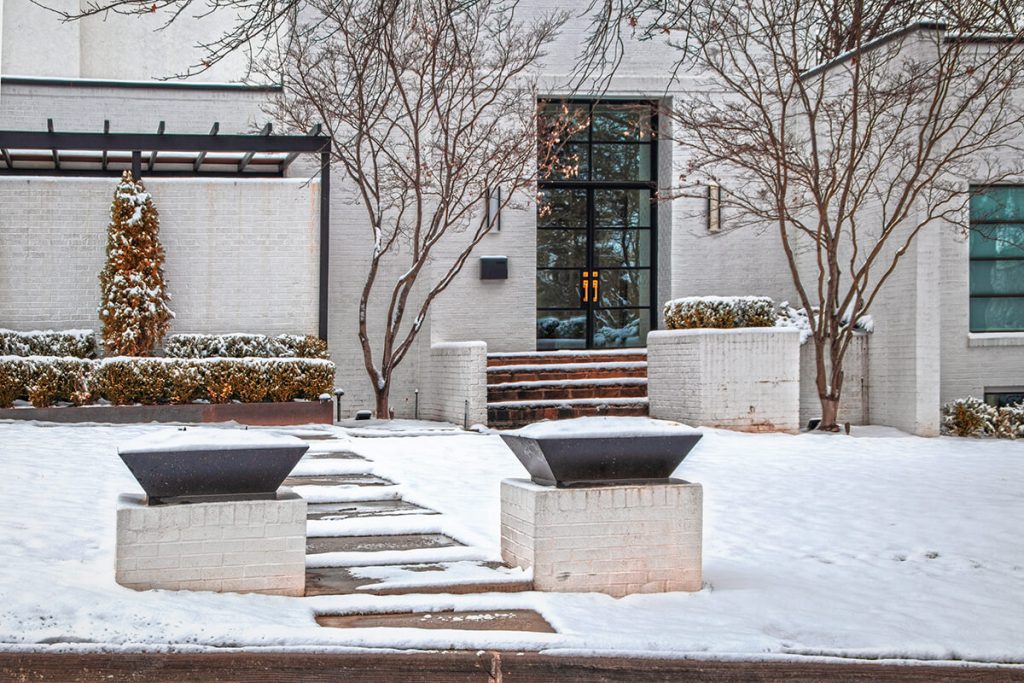
Winter brings a unique set of challenges for maintaining brick paver driveways and walkways. Snow and ice can make these areas unsafe to walk on, leading to long-term damage if not properly managed. Preparing your paver surfaces with the proper methods can ensure they stay safe and look their best, even during harsh winter conditions. Here’s a complete guide on managing ice and snow to keep your paver surfaces in top shape all season.
Use the Right De-Icer
One of the most critical steps in maintaining your brick pavers during winter is choosing the right de-icer. Not all de-icing products are safe for brick pavers, and some can cause damage to the pavers and the surrounding environment.
- Use de-icers sparingly. Only apply the minimum amount necessary to melt the snow and ice. Over applying the product can still result in damage to concrete.
- Avoid using sand. It doesn’t melt ice and can get trapped in the paver joints, leading to drainage issues and shifting.
Unilock’s Recommendations

A Touch of Green is a Unilock contractor, and we have some exclusive de-icing tips directly from the brand.
De-icing Chemicals
Preferred: Sodium Chloride (NaCl) for temperatures down to +20°F (-7°C). Sodium Chloride is commonly known as rock salt.
Only when necessary: Calcium Chloride (CaCl2) can be used for temperature ranges from below +20°F (-7°C) to -2°F (-19°C).
Unilock does not recommend using any other types of deicing chemicals. This includes:
- Magnesium Chloride (MgCl2)
- Calcium Magnesium Acetate (CMA)
- Potassium Chloride (KCl)
- Potassium Acetate (KA)
- Fertilizers containing Ammonium Nitrate and Ammonium Sulfate
“We recommend against using any products other than Sodium Chloride and Calcium Chloride. Our research has found some of the products listed as safe for concrete were incorrect or false and still caused damage to concrete and concrete pavers.”
Are there any recommendations for using de-icing products?
- Follow the directions listed on the deicing product bag.
- Sweep and remove any excess deicing chemical after the ice and snow melts.
- After the winter season, thoroughly wash the paver surface to remove any excess deicing chemical remaining.

Shovel Carefully
Shoveling is a necessity during snowy months, but with pavers, it’s essential to take extra care to prevent chipping or scratching.
- Clear snow often. The more frequently you clear snow, the less likely ice will form. Regular shoveling also reduces the buildup of de-icer.
- Shovel parallel to the paver joints. This method will help avoid catching the edges of the pavers and reduce the chance of chipping.
Plastic shovels are less likely to scratch or chip your pavers compared to metal ones. For additional protection, find a shovel with a rubber edge.
Use Snow Blowers with Caution
Snow blowers are effective for clearing large areas quickly, but they can damage pavers if not used carefully. Adjust the blade height to avoid direct contact with the pavers. Avoid pressing down too hard, which can catch the edges of your pavers and potentially cause chips or loosening.
Plan for Drainage
Melting snow and ice need somewhere to go. Proper drainage is essential to prevent water from pooling on your pavers, which could refreeze and cause damage. Ensure that any drainage channels, gutters, or nearby storm drains are clear of debris to prevent overflow onto your pavers.
Taking a proactive approach to winter maintenance will help your brick paver driveways and walkways last longer and look their best year-round. By using the right methods, you’ll be able to reduce winter wear and tear on your pavers and keep them safe and durable. With these steps, you can have a worry-free winter, knowing your paver surfaces are protected and ready for whatever the season brings.
Share
Related Posts



